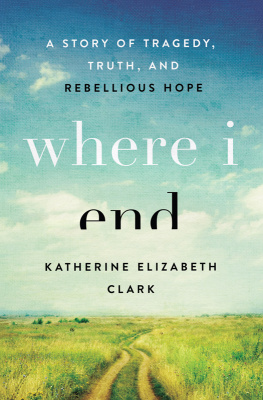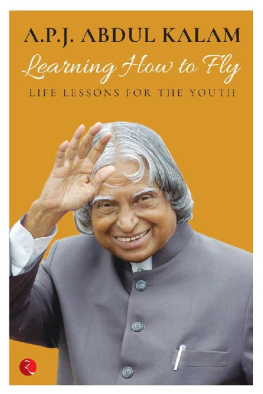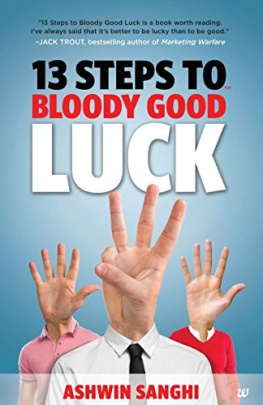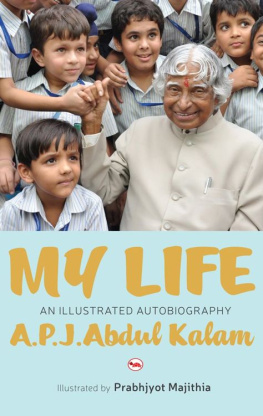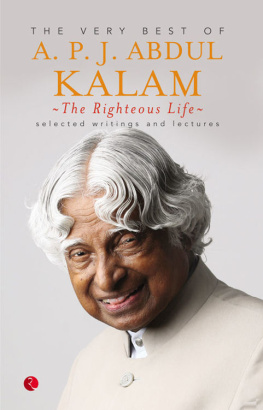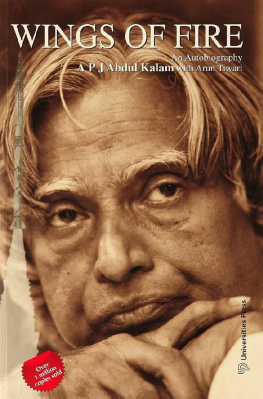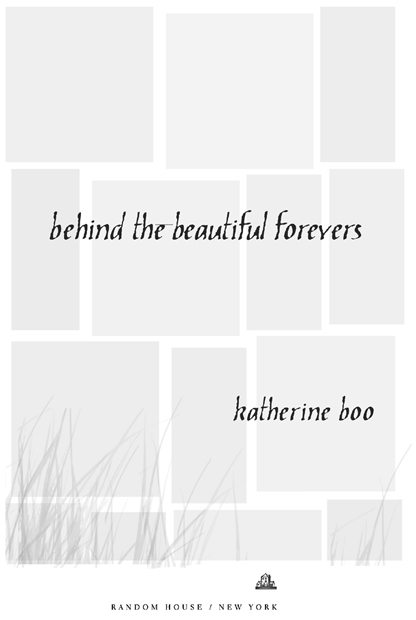Copyright 2012 by Katherine Boo
All rights reserved.
Published in the United States by Random House, an imprint of The Random House Publishing Group, a division of Random House, Inc., New York.
R ANDOM H OUSE and colophon are registered trademarks of Random House, Inc.
LIBRARY OF CONGRESS CATALOGING-IN-PUBLICATION DATA
Boo, Katherine.
Behind the beautiful forevers : life, death, and hope in a Mumbai undercity / Katherine Boo.
p. cm.
eISBN: 978-0-679-64395-1
1. Urban poorIndiaMumbai. I. Title.
HV 4140. M 86 B 66 2011
305.5690954792dc23 2011019555
www.atrandom.com
v3.1
For two Sunils
and what theyve taught me about not giving up
17. A School, a Hospital,
a Cricket Field
July 17, 2008Mumbai
Midnight was closing in, the one-legged woman was grievously burned, and the Mumbai police were coming for Abdul and his father. In a slum hut by the international airport, Abduls parents came to a decision with an uncharacteristic economy of words. The father, a sick man, would wait inside the trash-strewn, tin-roofed shack where the family of eleven resided. Hed go quietly when arrested. Abdul, the household earner, was the one who had to flee.
Abduls opinion of this plan had not been solicited, typically. Already he was mule-brained with panic. He was sixteen years old, or maybe nineteenhis parents were hopeless with dates. Allah, in His impenetrable wisdom, had cut him small and jumpy. A coward: Abdul said it of himself. He knew nothing about eluding policemen. What he knew about, mainly, was trash. For nearly all the waking hours of nearly all the years he could remember, hed been buying and selling to recyclers the things that richer people threw away.
Now Abdul grasped the need to disappear, but beyond that his imagination flagged. He took off running, then came back home. The only place he could think to hide was in his garbage.
He cracked the door of the family hut and looked out. His home sat midway down a row of hand-built, spatchcock dwellings; the lopsided shed where he stowed his trash was just next door. To reach this shed unseen would deprive his neighbors of the pleasure of turning him in to the police.
He didnt like the moon, though: full and stupid bright, illuminating a dusty open lot in front of his home. Across the lot were the shacks of two dozen other families, and Abdul feared he wasnt the only person peering out from behind the cover of a plywood door. Some people in this slum wished his family ill because of the old HinduMuslim resentments. Others resented his family for the modern reason, economic envy. Doing waste work that many Indians found contemptible, Abdul had lifted his large family above subsistence.
The open lot was quiet, at leastfreakishly so. A kind of beachfront for a vast pool of sewage that marked the slums eastern border, the place was bedlam most nights: people fighting, cooking, flirting, bathing, tending goats, playing cricket, waiting for water at a public tap, lining up outside a little brothel, or sleeping off the effects of the grave-digging liquor dispensed from a hut two doors down from Abduls own. The pressures that built up in crowded huts on narrow slumlanes had only this place, the maidan, to escape. But after the fight, and the burning of the woman called the One Leg, people had retreated to their huts.
Now, among the feral pigs, water buffalo, and the usual belly-down splay of alcoholics, there seemed to be just one watchful presence: a small, unspookable boy from Nepal. He was sitting, arms around knees, in a spangly blue haze by the sewage lakethe reflected neon signage of a luxury hotel across the water. Abdul didnt mind if the Nepali boy saw him go into hiding. This kid, Adarsh, was no spy for the police. He just liked to stay out late, to avoid his mother and her nightly rages.
It was as safe a moment as Abdul was going to get. He bolted for the trash shed and closed the door behind him.
Inside was carbon-black, frantic with rats, and yet relieving. His storeroom120 square feet, piled high to a leaky roof with the things in this world Abdul knew how to handle. Empty water and whiskey bottles, mildewed newspapers, used tampon applicators, wadded aluminum foil, umbrellas stripped to the ribs by monsoons, broken shoelaces, yellowed Q-tips, snarled cassette tape, torn plastic casings that once held imitation Barbies. Somewhere in the darkness, there was a Berbee or Barblie itself, maimed in one of the experiments to which children who had many toys seemed to subject those toys no longer favored. Abdul had become expert, over the years, at minimizing distraction. He placed all such dolls in his trash pile tits-down.
Avoid trouble. This was the operating principle of Abdul Hakim Husain, an idea so fiercely held that it seemed imprinted on his physical form. He had deep-set eyes and sunken cheeks, a body work-hunched and wirythe type that claimed less than its fair share of space when threading through people-choked slumlanes. Almost everything about him was recessed save the pop-out ears and the hair that curled upward, girlish, whenever he wiped his forehead of sweat.
A modest, missable presence was a useful thing in Annawadi, the sumpy plug of slum in which he lived. Here, in the thriving western suburbs of the Indian financial capital, three thousand people had packed into, or on top of, 335 huts. It was a continual coming-and-going of migrants from all over IndiaHindus mainly, from all manner of castes and subcastes. His neighbors represented beliefs and cultures so various that Abdul, one of the slums three dozen Muslims, could not begin to understand them. He simply recognized Annawadi as a place booby-trapped with contentions, new and ancient, over which he was determined not to trip. For Annawadi was also magnificently positioned for a trafficker in rich peoples garbage.
Abdul and his neighbors were squatting on land that belonged to the Airports Authority of India. Only a coconut-tree-lined thoroughfare separated the slum from the entrance to the international terminal. Serving the airport clientele, and encircling Annawadi, were five extravagant hotels: four ornate, marbly megaliths and one sleek blue-glass Hyatt, from the top-floor windows of which Annawadi and several adjacent squatter settlements looked like villages that had been airdropped into gaps between elegant modernities.
Everything around us is roses is how Abduls younger brother, Mirchi, put it. And were the shit in between.
In the new century, as Indias economy grew faster than any other but Chinas, pink condominiums and glass office towers had shot up near the international airport. One corporate office was named, simply, More. More cranes for making more buildings, the tallest of which interfered with the landing of more and more planes: It was a smogged-out, prosperity-driven obstacle course up there in the overcity, from which wads of possibility had tumbled down to the slums.
Every morning, thousands of waste-pickers fanned out across the airport area in search of vendible excessa few pounds of the eight thousand tons of garbage that Mumbai was extruding daily. These scavengers darted after crumpled cigarette packs tossed from cars with tinted windows. They dredged sewers and raided dumpsters for empty bottles of water and beer. Each evening, they returned down the slum road with gunny sacks of garbage on their backs, like a procession of broken-toothed, profit-minded Santas.



